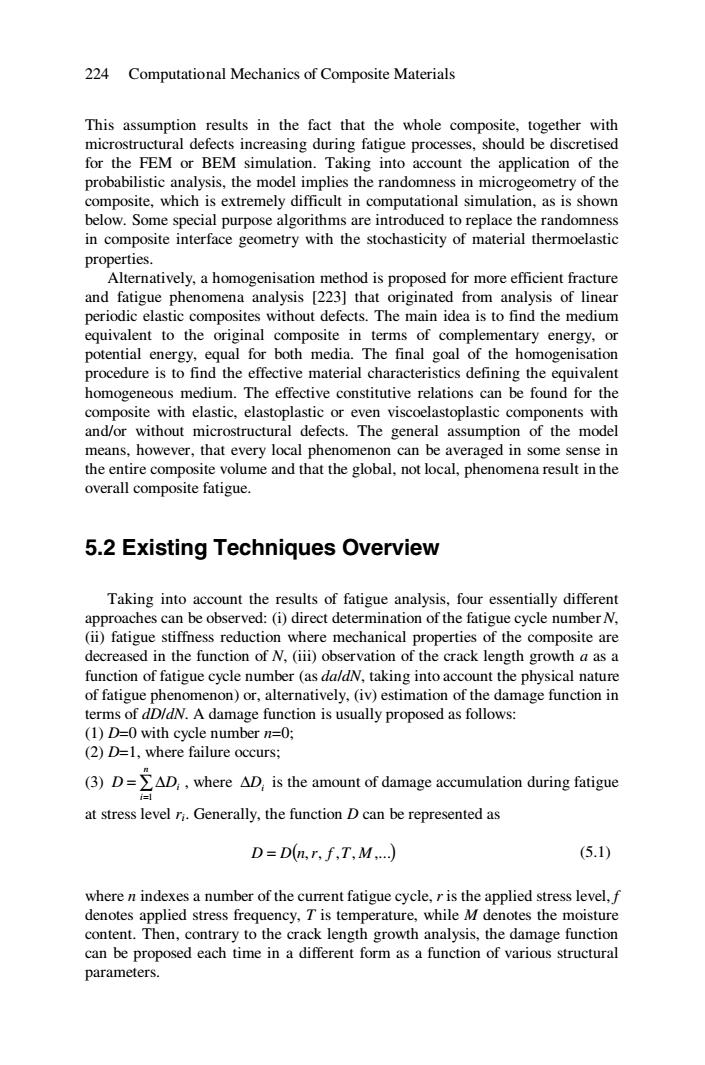正在加载图片...

224 Computational Mechanics of Composite Materials This assumption results in the fact that the whole composite,together with microstructural defects increasing during fatigue processes,should be discretised for the FEM or BEM simulation.Taking into account the application of the probabilistic analysis,the model implies the randomness in microgeometry of the composite,which is extremely difficult in computational simulation,as is shown below.Some special purpose algorithms are introduced to replace the randomness in composite interface geometry with the stochasticity of material thermoelastic properties. Alternatively,a homogenisation method is proposed for more efficient fracture and fatigue phenomena analysis [223]that originated from analysis of linear periodic elastic composites without defects.The main idea is to find the medium equivalent to the original composite in terms of complementary energy,or potential energy,equal for both media.The final goal of the homogenisation procedure is to find the effective material characteristics defining the equivalent homogeneous medium.The effective constitutive relations can be found for the composite with elastic,elastoplastic or even viscoelastoplastic components with and/or without microstructural defects.The general assumption of the model means,however,that every local phenomenon can be averaged in some sense in the entire composite volume and that the global,not local,phenomena result in the overall composite fatigue. 5.2 Existing Techniques Overview Taking into account the results of fatigue analysis,four essentially different approaches can be observed:(i)direct determination of the fatigue cycle number N, (ii)fatigue stiffness reduction where mechanical properties of the composite are decreased in the function of N,(iii)observation of the crack length growth a as a function of fatigue cycle number(as da/dN,taking into account the physical nature of fatigue phenomenon)or,alternatively,(iv)estimation of the damage function in terms of dD/dN.A damage function is usually proposed as follows: (1)D=0 with cycle number n=0; (2)D=1,where failure occurs; (3)D=AD,where AD is the amount of damage accumulation during fatigue at stress level ri.Generally,the function D can be represented as D=D(n,r,f,T,M....) (5.1) where n indexes a number of the current fatigue cycle,r is the applied stress level,f denotes applied stress frequency,T is temperature,while M denotes the moisture content.Then,contrary to the crack length growth analysis,the damage function can be proposed each time in a different form as a function of various structural parameters.224 Computational Mechanics of Composite Materials This assumption results in the fact that the whole composite, together with microstructural defects increasing during fatigue processes, should be discretised for the FEM or BEM simulation. Taking into account the application of the probabilistic analysis, the model implies the randomness in microgeometry of the composite, which is extremely difficult in computational simulation, as is shown below. Some special purpose algorithms are introduced to replace the randomness in composite interface geometry with the stochasticity of material thermoelastic properties. Alternatively, a homogenisation method is proposed for more efficient fracture and fatigue phenomena analysis [223] that originated from analysis of linear periodic elastic composites without defects. The main idea is to find the medium equivalent to the original composite in terms of complementary energy, or potential energy, equal for both media. The final goal of the homogenisation procedure is to find the effective material characteristics defining the equivalent homogeneous medium. The effective constitutive relations can be found for the composite with elastic, elastoplastic or even viscoelastoplastic components with and/or without microstructural defects. The general assumption of the model means, however, that every local phenomenon can be averaged in some sense in the entire composite volume and that the global, not local, phenomena result in the overall composite fatigue. 5.2 Existing Techniques Overview Taking into account the results of fatigue analysis, four essentially different approaches can be observed: (i) direct determination of the fatigue cycle number N, (ii) fatigue stiffness reduction where mechanical properties of the composite are decreased in the function of N, (iii) observation of the crack length growth a as a function of fatigue cycle number (as da/dN, taking into account the physical nature of fatigue phenomenon) or, alternatively, (iv) estimation of the damage function in terms of dD/dN. A damage function is usually proposed as follows: (1) D=0 with cycle number n=0; (2) D=1, where failure occurs; (3) ∑ = = ∆ n i D Di 1 , where ∆Di is the amount of damage accumulation during fatigue at stress level ri. Generally, the function D can be represented as D = D( ) n,r, f ,T, M ,... (5.1) where n indexes a number of the current fatigue cycle, r is the applied stress level, f denotes applied stress frequency, T is temperature, while M denotes the moisture content. Then, contrary to the crack length growth analysis, the damage function can be proposed each time in a different form as a function of various structural parameters